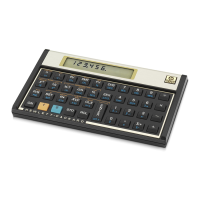Section 3: Basic Financial Functions 65
File name: HP 12cpt_user's guide_English_110608.DOC Page: 71 of 285
Printed Date: 2009/1/13 Dimension: 14.8 cm x 21 cm
The fractional part of n can be determined using either the actual number of odd
days or the number of odd days counted on the basis of a 30-day month.
*
The
gÒ
function can be used to calculate the number of odd days either way. The
fractional part of n is a fraction of a payment period, so the number of odd days
must be divided by the number of days in a period. If interest is compounded
monthly, for this number you can use either 30, 365/12, or (if the odd period falls
entirely within a single month) the actual number of days in that month. Usually, a
monthly period is taken to be 30 days long.
At your option, the calculations of i, PV, PMT, and FV can be performed with either
simple interest or compound interest accruing during the odd period. If the
C
status
indicator in the display is not lit, simple interest is used. To specify compound
interest, turn the
C
indicator on by pressing
?Æ
.
†
Pressing
?Æ
again
turns the
C
indicator off, and calculations will then be performed using simple
interest for the odd period.
Example 1:
A 36-month loan for $4,500 accrues interest at a 5% annual
percentage rate (APR), with the payments made at the end of each month. If
interest begins accruing on this loan on February 15, 2004 (so that the first period
begins on March 1, 2004), calculate the monthly payment, with the odd days
counted on the basis of a 30-day month and compound interest used for the odd
period.
Keystrokes
(RPN mode)
Display
f
CLEAR
G
Clears financial registers.
gÕ
Sets date format to month-day-year.
gÂ
Sets payment mode to End.
?Æ
Turns on the
C
indicator in the
display, so that compound interest
will be used for the odd period.
2.152004
\
2.15
Keys in the date interest begins
accruing and separates it from the
next date entered.
3.012004
3.012004
Keys in the date of the beginning of
the first period.
*
The two methods of counting odd days will yield slightly different answers. If you are
calculating i to determine the annual percentage rate (APR) for an odd-period transaction, the
lower APR will result if the calculation uses the greater number of odd days determined using
the two methods.
†
?Æ is not programmable.

